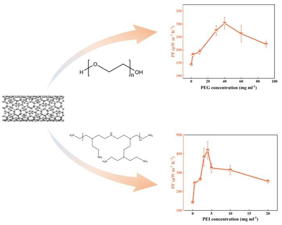Home > Press > Enhancing power factor of p- and n-type single-walled carbon nanotubes
 |
| Schematic diagram of preparation of p-SWCNTs and n-SWCNTs with high power factor via PEG and PEI solution processing
Credit Cun-Yue Guo, University of Chinese Academy of Sciences |
Abstract:
Single-walled carbon nanotubes (SWCNTs) possess advantages of high thermal stability, high flexibility, lightweight, easy controllable doping level. Their thermoelectric properties are almost comparable to those of conducting polymers and their composites, however there are few studies on them as thermoelectric materials alone and the mechanism of molecular doping remains to be well understood. Researchers based at University of Chinese Academy of Sciences improve the thermoelectric properties of p-type and n-type SWCNTs by 2 times and 3 times with solution processing methods.
Enhancing power factor of p- and n-type single-walled carbon nanotubes
Beijing, China | Posted on April 25th, 2025
They published their work on Aug. 19 in Energy Material Advances.
With the development of renewable energy, thermoelectric (TE) materials have aroused great interest and wide attention in academia and industry because of their cleanness, cost effectiveness, low pollution to environment, and direct conversion between heat and electricity without moving parts. said paper author Cun-Yue Guo, professor with School of Chemical Sciences, University of Chinese Academy of Sciences.
Organic thermoelectric materials (OTE) have their unique advantages in more abundance in nature, low-cost, large-scale production, and higher efficiency at temperature below 150 ℃. Guo said. Among them, single-walled carbon nanotubes (SWCNTs) alone can be regarded as a high performance organic thermoelectric material with comparable performance to semiconductor polymers.
Guo explained that p-type and n-type doping of SWCNTs are conducive to the preparation of thermoelectric generator devices in practical applications.
With the addition of polyethylene glycol (PEG) with low molecular weight (Mn = 600 g mol⁻1), the Seebeck coefficient increased slightly and the electrical conductivity increased by 60% meanwhile, making power factor of p-SWCNTs to 303.17 ± 46.25 μW m⁻1 K⁻2, above twice the PF value of pristine SWCNTs (142.58 μW m⁻1 K⁻2). Guo said.
With the addition of polyethyleneimine (PEI), the Seebeck coefficient turned negative and the electrical conductivity increased a lot, making power factor of n-SWCNTs to 418.49 ± 46.30 μW m⁻1 K⁻2, about three times the PF value of pristine SWCNTs. Guo said.
Various characterizations were used to explore the doping mechanism of p-SWCNTs and n-SWCNTs. And its supposed that herein the underlying mechanism of p-SWCNTs comes from energy filtering effect. PEG absorbed on SWCNTs generated electron polarization and interface polarization, causing changes in energy band and energy barrier. The suitable energy barrier can filter out low energy carriers and allow only high energy carriers to pass through, and this energy filtering effect can be the reason for the increase of the Seebeck coefficient. The underlying mechanism of n-SWCNTs comes from charge transfer process. That is PEI injected electron carriers into SWCNTs and turned the Seebeck coefficient negative.
p-SWCNTs exhibited the behavior of metallic SWCNTs. Guo said. While n-SWCNTs exhibited the behavior of semiconductor SWCNTs, as revealed by Raman and variable temperature thermoelectric parameters tests.
n-SWCNTs were injected with n-type electron carriers during charge transfer, so the Fermi energy level increased and the work function decreased. In contrast, the hole carrier concentration of p-SWCNTs increased, so the Fermi energy level decreased and the work function increased. Guo said.
Other contributors include Xin Wu, Peiyao Liu, Bingchen Huo, Yiyang Li, Shuang Liu and Yifan Lv, School of Chemical Sciences, University of Chinese Academy of Sciences.
The National Natural Science Foundation of China (51373176) supported this work.
About Dr. Cun-Yue Guo
Dr. Guo is currently a professor at the University of Chinese Academy of Sciences (UCAS). His interests focus on energy conversion materials, carbon dioxide utilization, and polymer composites. Dr. Guo completed his Ph.D. in Polymer Chemistry and Physics from the Institute of Chemistry, Chinese Academy of Sciences (ICCAS), and has been awarded Zhu Liyuehua Excellent Teacher Award of Chinese Academy of Sciences (CAS) in 2023 and Research Fellowship Award from DAAD – K. C. Wong Fellowships in 2007. He hosted several projects of the National Natural Science Foundation of China as a principal investigator.
####
For more information, please click here
Contacts:
Ning Xu
Beijing Institute of Technology Press Co., Ltd
Copyright © Beijing Institute of Technology Press Co., Ltd
If you have a comment, please Contact us.
Issuers of news releases, not 7th Wave, Inc. or Nanotechnology Now, are solely responsible for the accuracy of the content.
News and information
![]()
Tumor microenvironment dynamics: the regulatory influence of long non-coding RNAs April 25th, 2025
![]()
Ultrafast plasmon-enhanced magnetic bit switching at the nanoscale April 25th, 2025
![]()
Next-generation drug delivery innovation! DGIST develops precision therapeutics using exosomes April 25th, 2025
Possible Futures
![]()
Lattice-driven charge density wave fluctuations far above the transition temperature in Kagome superconductor April 25th, 2025
![]()
Tumor microenvironment dynamics: the regulatory influence of long non-coding RNAs April 25th, 2025
![]()
Ultrafast plasmon-enhanced magnetic bit switching at the nanoscale April 25th, 2025
![]()
Next-generation drug delivery innovation! DGIST develops precision therapeutics using exosomes April 25th, 2025
Chip Technology
![]()
Ultrafast plasmon-enhanced magnetic bit switching at the nanoscale April 25th, 2025
![]()
New ocelot chip makes strides in quantum computing: Based on “cat qubits,” the technology provides a new way to reduce quantum errors February 28th, 2025
![]()
Bringing the power of tabletop precision lasers for quantum science to the chip scale December 13th, 2024
Nanotubes/Buckyballs/Fullerenes/Nanorods/Nanostrings
![]()
Chainmail-like material could be the future of armor: First 2D mechanically interlocked polymer exhibits exceptional flexibility and strength January 17th, 2025
![]()
Innovative biomimetic superhydrophobic coating combines repair and buffering properties for superior anti-erosion December 13th, 2024
Discoveries
![]()
Lattice-driven charge density wave fluctuations far above the transition temperature in Kagome superconductor April 25th, 2025
![]()
HKU physicists uncover hidden order in the quantum world through deconfined quantum critical points April 25th, 2025
![]()
Nanophotonic platform boosts efficiency of nonlinear-optical quantum teleportation April 25th, 2025
Materials/Metamaterials/Magnetoresistance
![]()
Chainmail-like material could be the future of armor: First 2D mechanically interlocked polymer exhibits exceptional flexibility and strength January 17th, 2025
![]()
Enhancing transverse thermoelectric conversion performance in magnetic materials with tilted structural design: A new approach to developing practical thermoelectric technologies December 13th, 2024
![]()
FSU researchers develop new methods to generate and improve magnetism of 2D materials December 13th, 2024
Announcements
![]()
Tumor microenvironment dynamics: the regulatory influence of long non-coding RNAs April 25th, 2025
![]()
Ultrafast plasmon-enhanced magnetic bit switching at the nanoscale April 25th, 2025
![]()
Next-generation drug delivery innovation! DGIST develops precision therapeutics using exosomes April 25th, 2025
Interviews/Book Reviews/Essays/Reports/Podcasts/Journals/White papers/Posters
![]()
Nanophotonic platform boosts efficiency of nonlinear-optical quantum teleportation April 25th, 2025
![]()
Tumor microenvironment dynamics: the regulatory influence of long non-coding RNAs April 25th, 2025
Battery Technology/Capacitors/Generators/Piezoelectrics/Thermoelectrics/Energy storage
![]()
Leading the charge to better batteries February 28th, 2025
![]()
Enhancing transverse thermoelectric conversion performance in magnetic materials with tilted structural design: A new approach to developing practical thermoelectric technologies December 13th, 2024
![]()
Breakthrough brings body-heat powered wearable devices closer to reality December 13th, 2024










